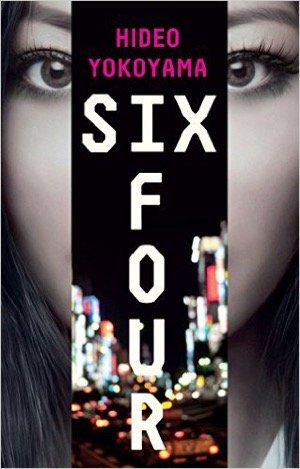
Translated by Jonathan Lloyd-Davies — The main attraction of a police procedural is the opportunity for readers to watch the characters develop over a series of short, complex novels – Ed McBain’s 87th Precinct novels, for example, or Sjöwall and Wahlöö’s Martin Beck series. Both offer an apparently realistic depiction of police life in their respective nations, with small details about the central characters being dropped into the tightly woven plots; plots driven mainly by police investigation.
Six Four is different. It’s much longer than any similar novel you’re likely to find. 635 pages, in fact, impressively bound in a tall hardcover. There’s also an overwhelming amount of detail about the bureaucracy of Japanese police. Underneath all that it’s an interesting and detailed account of police work in Japan, with its unique challenges.
Six Four takes place in 2002, or Heisei 14 in the Japanese dating system, in which the era changes when an Emperor dies and a new one is crowned. The novel takes place in D– Prefecture, a fictional region four hours away from Tokyo, struggling to maintain independence from the National Police Agency. Police Superintendent Yoshinobu Mikami has been floundering. He’s been transferred to Administrative Affairs to work as press director. Transfers like this occur in every Japanese workplace once a year – for most it’s just a step in their career, but some transfers are personal, intended to move the individual into a dead-end role where they either quit or fail. On top of struggling with suspicion and hatred directed at him from both the press and from within the police force, Mikami also has to deal with the loss of his teenage daughter, who disappeared recently, and a kidnapping that bears a striking resemblance to an unsolved crime committed 14 years earlier.
That first kidnapping is referred to by the police who investigated it as ‘Six Four’ because it occurred in the 64th year of the Showa period; Showa 64 only lasted seven days, ending with the death of Showa Emperor Hirohito on 7 January, 1989. The investigation into the kidnapping featured a number of errors by the local police – most prominently a telephone conversation that wasn’t recorded, and then covered up – which would be very embarrassing for the local force if they ever came to light. As the police investigating Six Four tried in vain to search for the criminal, their bungling meant he was able to get away with the ransom money and dispose of his victim.
Our hero Mikami is determined that the most recent kidnapping will not end the same way as the kidnapping 14 years earlier. While struggling to deal with the unwieldy local press, Mikami begins to search for the truth about Six Four. What he uncovers is a web of conspiracies and cover-ups, self-interest posing as collective interest – and a lot of detail that can sometimes overwhelm the reader.
Japanese novels are notoriously poorly-edited. The way you receive them is often very close to the way the author wrote them, with very few changes. This is sometimes polished up in translation, but in the case of Six Four this would not have been possible without major changes. Six Four is, I believe, two very good novels posing as one. With a little restructuring this could be very different. In fact it was published in Japan as two novels, as is standard for a novel this size. It would certainly be unwieldy to read a novel like this in Japan’s small paperback format. I feel that dividing the experience of reading Six Four into two parts would make for a much more exciting read, that wouldn’t drag in the way that Six Four occasionally does in pursuit of its intriguing, and surprising, conclusion.
Still, as police procedurals go, this is both a wonderful read, and an excellent window for Western readers into Japanese crime fiction and how its police service operates. The book (or books) sold over 1.3 million copies in Japan, making Six Four one of the most popular examples of Japanese crime fiction in its native country.
You can listen to the first two chapters of Six Four right here on our site.
Quercus
Print/Kindle/iBook
£9.99
CFL Rating: 4 Stars









